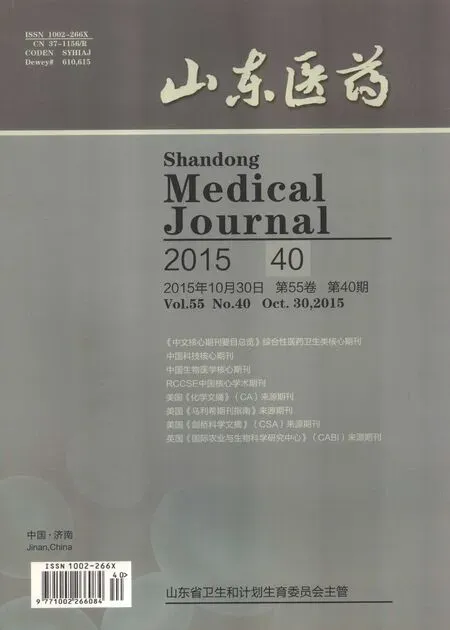血管内皮生长因子靶向药物治疗难治性分化型甲状腺癌的研究进展
2015-04-04肖雄王新华董占飞
肖雄,王新华,董占飞
(新疆医科大学附属肿瘤医院,乌鲁木齐830054)
难治性分化型甲状腺癌(DTC)是分化型甲状腺癌细胞失分化所致,因失分化后的癌细胞丧失了摄取放射性碘的能力,故临床上对其针对性的治疗方法十分有限[1,2]。随着分子靶向治疗在肿瘤治疗领域研究中的进展,关于DTC分子靶向治疗的研究逐渐被关注,其中研究较多的是血管内皮生长因子(VEGF)靶向途径[3]。VEGF家族包括7种糖蛋白(VEGF-A、VEGF-B、VEGF-C、VEGF-D、VEGF-E 及PlGF-1、PlGF-2)和 3种酪氨酸蛋白激酶受体(VEGR-1、VEGR-2、VEGR-3)[4],主要由肿瘤细胞和骨髓原始细胞分泌[5,6],可通过多种机制促进肿瘤血管生成及血流量增加,并促进骨髓源血管祖细胞的趋化与归巢[7]。研究显示,VEGF表达与肿瘤的侵袭和转移有关,一旦VEGF表达失调,随着血管形成的增加,肿瘤的侵袭性和转移性增强[8]。现结合文献就VEGF靶向药物在难治性DTC治疗中的应用作一综述。
1 VEGF与难治性DTC的关系
1.1 VEGF与难治性DTC形成及转移的关系 研究发现,存在淋巴结转移的甲状腺乳头状癌(PTC)患者VEGF-D表达水平明显高于无淋巴结转移者[9],而VEGF-C和VEGF-D表达与淋巴结转移有关。推测VEGF能诱导淋巴表皮细胞增殖和淋巴管生长[10];鞘氨醇磷酸酯与VEGR-2信号通路相关,可促进甲状腺癌细胞增殖与迁移[11]。也有研究认为,VEGF-C及其抗体VEGR-3的表达与微淋巴管密度增加有关,两者在良、恶性肿瘤组织中的表达存在明显差异[12,13]。因此,VEGF 表达升高可能与DTC发生转移和形成难治性DTC有关。
1.2 VEGF与难治性DTC患者预后的关系 随着不同种类VEGF表达与甲状腺癌侵袭性研究的深入,VEGF的表达与难治性DTC患者预后之间的关系也逐渐被关注。Hsueh等[14]发现,难治性DTC患者行甲状腺全切术后,复发患者体内所有类型的VEGF水平均上升。另有研究认为,VEGF和血管生存素-1、血管生存素-2的表达均影响难治性DTC患者的临床分期与预后。国外研究认为,VEGF的表达与类胰岛素生长因子-1和类胰岛素样生长因子-1受体表达相关,难治性DTC患者VEGR-1表达可作为存在淋巴结转移的预测指标,同时患者行甲状腺全切术后血清VEGF水平表达增加可作为甲状腺癌复发和进展的预测指标,VEGF水平越高,患者预后越差[15]。国内学者研究发现,难治性 DTC患者VEGF水平显著高于结节性甲状腺肿患者及健康人群[16]。目前较多VEGF表达与难治性DTC患者预后关系的研究,如敏感性高、具有预测患者预后的VEGF类别及其最佳临界值的相关研究等。定期对存在转移和复发风险的患者进行VEGF表达检测,可为预测难治性DTC患者术后是否存在肿瘤进展和评价预后提供一种新的监测手段。
2 VEGF靶向药物在难治性DTC治疗中的应用
2.1 基础研究药物
2.1.1 舒尼替尼 国外一项放疗联合舒尼替尼用于治疗滤泡状甲状腺癌(FTC)的研究发现,放疗联合舒尼替尼可通过激活细胞内在的凋亡机制诱导FTC细胞凋亡。舒尼替尼能够下调凋亡抑制基因survivin的表达,进而诱导肿瘤细胞凋亡[17]。也有研究认为,舒尼替尼能够靶向作用于RET/PTC细胞株的细胞质基质MEK/ERK及SAPK/JNK通路,通过阻断这些通路来阻碍肿瘤细胞的增殖;舒尼替尼作用后,RET/PTC细胞株的钠碘同向转运体基因表达增强,表明RET/PTC细胞株对放射性碘治疗的敏感性增强[18]。利用舒尼替尼作用于BRAF基因突变的难治性DTC细胞株8305C和未分化型甲状腺癌细胞株FB3,发现舒尼替尼可以通过阻碍Akt及ERK1/2磷酸化而抑制细胞增殖[19]。
2.1.2 其他 Gule等[20]采用凡德他尼作用于未分化型甲状腺癌Heh83和8505c细胞株,发现凡德他尼可显著抑制二者的活性。Mologni等[21]报道,普纳替尼对于RET表达阳性、BCR表达阴性、ABL表达阳性的难治性DTC细胞均有明显的增殖抑制作用。此外,对凡德他尼具有耐药性的V804M/L突变细胞,可以采用普纳替尼进行治疗。近期一项研究发现,索拉非尼与脂质体阿霉素联合应用可显著降低低分化型甲状腺癌细胞的活性,二者联合使用较单独使用索拉非尼治疗效果更好[22]。Tohyama等[23]研究显示,兰伐替尼不仅可以阻碍 FGFR和RET信号通路,还具有抗血管再生作用,从而降低难治性DTC细胞的活性。
2.2 临床研究药物
2.2.1 三期临床试验药物
2.2.1.1 索拉非尼 索拉非尼是临床上研究最多的治疗难治性DTC的VEGF靶向治疗药物。国外一项双盲、随机、多中心的三期临床试验研究显示,服用索拉非尼14个月后,难治性DTC患者的无瘤生存时间(PFS)为10.5个月,显著高于服用安慰剂患者(5.8个月);同时发现,无论何种突变类型的难治性DTC患者,经索拉非尼治疗其临床症状和基因标志物都得到改善。目前索拉非尼已通过FDA的批准,并广泛应用于难治性 DTC患者的治疗[24]。但应注意索拉非尼可引起患者手足综合征、腹泻、脱发、皮疹等不良反应。
2.2.1.2 凡德他尼 凡德他尼是一种合成的苯胺喹唑啉化合物,可同时作用于肿瘤细胞EGFR、VEGFR和RET酪氨酸激酶。最近一项关于凡德他尼治疗伴转移性甲状腺髓样癌的三期临床试验研究显示,52例患者中位PFS为16.1个月,其中12例部分缓解、33例病情稳定、7例恶化。患者在治疗过程中均至少伴有1种不良反应,如皮肤反应、腹泻、虚弱等[25]。
2.2.1.3 兰伐替尼 近期一项随机、对照、双盲三期临床试验研究显示,经兰伐替尼治疗的难治性DTC患者中位PFS为18.3个月、有效率为64.8%,均显著高于对照组,但是治疗后有40%患者出现高血压、腹泻、疲倦等不良反应。另外有研究显示,兰伐替尼可显著延长难治性DTC患者的PFS并改善病情,但其可引起高血压、腹泻、关节痛等不良反应,应引起足够重视[26]。
2.2.2 二期临床试验药物 一项关于舒尼替尼治疗难治性DTC的研究表明,11例患者(试验组)经舒尼替尼治疗后完全缓解1例、部分缓解2例、病情稳定5例,总体有效率为72%,显著高于对照组,且其血清甲状腺球蛋白下降速率更快。但舒尼替尼也可引起疲劳、黏膜炎症、手足综合征等不良反应[27]。一项关于阿希替尼的二期临床试验显示,对60例难治性DTC患者给予阿希替尼治疗后,18例病情稳定时间超过16周,随访3年发现患者中位存活时间为35个月,中位PFS为15个月,中位疾病持续缓解时间为21个月;但75%患者出现了高血压、蛋白尿、腹泻等不良反应[28]。一项多中心帕唑帕尼治疗难治性DTC的二期临床试验研究显示,其总有效率为49%,且患者均能耐受药物不良反应,但仍需三期临床试验加以证实[29]。
目前,难治性DTC仍缺少有效的治疗方法。由于VEGF通路与DTC向难治性DTC转变有关,故关于抗VEGF通路靶向药物的研究成为近年来研究的热点。但VEGF表达对难治性DTC患者预后的预测价值还需更多的前瞻性研究加以证实,并且VEGF靶向药物引起的不良反应也需要引起重视。
[1]Gruber JJ,Colevas AD.Differentiated thyroid cancer:focus on emerging treatments for radioactive iodine-refractory patients[J].Oncologist,2015,20(2):113-126.
[2]Rivera M,Ghossein RA,Schoder H,et al.Histopathologic characterization of radioactive iodine-refractory fluorodeoxyglucose-positron emission tomography-positive thyroid carcinoma[J].Cancer,2008,113(1):48-56.
[3]刘泽明,李大鹏,黄韬,等.甲状腺癌分子靶向治疗的现状和前景展望[J].中国现代普通外科进展,2013,16(1):43-46.
[4]Hicklin DJ,Ellis LM.Role of the vascular endothelial growth factor pathway in tumor growth and angiogenesis[J].J Clin Oncol,2005,23(5):1011-1027.
[5]Zhan J,Li Y,Yu J,et al.Culture medium of bone marrow-derived human mesenchymal stem cells effects lymphatic endothelial cells and tumor lymph vessel formation[J].Oncol Lett,2015,9(3):1221-1226.
[6]Yue P,Zhang X,Paladino D,et al.Hyperactive EGF receptor,Jaks and Stat3 signaling promote enhanced colony-forming ability,motility and migration of cisplatin-resistant ovarian cancer cells[J].Oncogene,2012,31(18):2309-2322.
[7]Smith NR,Baker D,James NH,et al.Vascular endothelial growth factor receptors VEGFR-2 and VEGFR-3 are localized primarily to the vasculaturein human primary solid cancers[J].Clin Cancer Res,2010,16(14):3548-3561.
[8]Mittal K,Ebos J,Rini B.Angiogenesis and the tumor microenvironment:vascular endothelial growth factor and beyond[J].Semin Oncol,2014,41(2):235-251.
[9]Lai CW,Chen KY,Hung CS,et al.Serum vascular endothelial growth factor-D levels correlate with cervical lymph node metastases in papillary thyroid carcinoma[J].Growth Factors,2011,29(2-3):57-62.
[10]Luo H,Li J,Yang T,et al.Expression and significance of VEGFC and VEGF-D in differentiated thyroid carcinoma[J].Lin Chung Er Bi Yan Hou Tou Jing Wai Ke Za Zhi,2009,23(12):531-534.
[11] Törnquist K.Sphingosine 1-phosphate and cancer:lessons from thyroid cancer cells[J].Biomolecules,2013,3(2):303-315.
[12]Omoto I,Matsumoto M,Okumura H,et al.Expression of vascular endothelial growth factor-C and vascular endothelial growth factor receptor-3 in esophageal squamous cell carcinoma[J].Oncol Lett,2014,7(4):1027-1032.
[13] Garcia EA,Simoes K,Wakamatsu A,et al.Lymphatic vessel density and VEGF-C expression are significantly different among benign and malignant thyroid lesions[J].Endocr Pathol,2010,21(2):101-107.
[14]Hsueh C,Lin JD,Wu IC,et al.Vascular endothelial growth factors and angiopoietins in presentations and prognosis of papillary thyroid carcinoma[J].J Surg Oncol,2011,103(5):395-399.
[15]Karaca Z,Tanriverdi F,Unluhizarci K,et al.VEGFR1 expression is related to lymph node metastasis and serum VEGF may be a marker of progression in the follow-up of patients with differentiated thyroid carcinoma[J].Eur J Endocrinol,2011,164(2):277-284.
[16]杨晶晶,李寅辉,朱筠,等.血清肿瘤特异性生长因子与血管内皮生长因子检测对甲状腺癌的早期诊断价值[J].中国医师进修杂志,2014,37(17):12-14.
[17]Grosse J,Warnke E,Wehland M,et al.Mechanisms of apoptosis in irradiated and sunitinib-treated follicular thyroid cancer cells[J].Apoptosis,2014,19(3):480-490.
[18] Fenton MS,Marion KM,Salem AK,et al.Sunitinib inhibits MEK/ERK and SAPK/JNK pathways and increases sodium/iodide symporter expression in papillary thyroid cancer[J].Thyroid,2010,20(9):965-974.
[19]Di Desidero T,Fioravanti A,Orlandi P,et al.Antiproliferative and proapoptotic activity of sunitinib on endothelial and anaplastic thyroid cancer cells via inhibition of Akt and ERK1/2 phosphorylation and by down-regulation of cyclin-D1[J].J Clin Endocrinol Metab,2013,98(9):1465-1473.
[20]Gule MK,Chen Y,Sano D,et al.Targetedtherapy of VEGFR2 and EGFR significantly inhibits growth of anaplastic thyroidcancer in an orthotopic murine model[J].Clin Cancer Res,2011,17(8):2281-2291.
[21]Mologni L,Redaelli S,Morandi A,et al.Ponatinib is a potent inhibitor of wild-type and drug-resistant gatekeeper mutant RET kinase[J].Mol Cell Endocrinol,2013,377(1-2):1-6.
[22]An CM,Wang Z,Han ZK,et al.Effects of sorafenib andliposome doxorubicin on human poorly differentiated thyroid carcinoma xenografts in nude mice[J].Zhonghua Er Bi Yan Hou Tou Jing Wai Ke Za Zhi,2012,47(11):931-936.
[23]Tohyama O,Matsui J,Kodama K,et al.Antitumor activity of lenvatinib(e7080):an angiogenesis inhibitor that targets multiple receptor tyrosine kinases in preclinical human thyroid cancer models[J].J Thyroid Res,2014,(2014):638747.
[24]Brose MS,Nutting CM,Jarzab B,et al.Sorafenib in radioactive iodine-refractory,locally advanced or metastatic differentiated thyroid cancer:a randomised,double-blind,phase 3 trial[J].Lancet,2014,384(9940):319-328.
[25]Chougnet CN,Borget I,Leboulleux S,et al.Vandetanib for the Treatment of AdvancedMedullary Thyroid Cancer Outside a Clinical Trial:Results from a French Cohort[J].Thyroid,2015,25(4):386-391.
[26] Schlumberger M,Tahara M,Wirth LJ,et al.Lenvatinib versus placebo in radioiodine-refractory thyroid cancer[J].N Engl J Med,2015,372(7):621-630.
[27] Díez JJ,Iglesias P,Alonso T,et al.Activity and safety of sunitinib inpatients with advanced radioactive iodine-refractory differentiated thyroid carcinoma in clinical practice[J].Endocrine,2015,48(2):582-588.
[28]Cohen EE,Tortorici M,Kim S,et al.A PhaseⅡ trial of axitinib in patients with various histologic subtypes of advanced thyroid cancer:long-term outcomes and pharmacokinetic pharmacodynamic analyses[J].Cancer Chemother Pharmacol,2014,74(6):1261-1270.
[29]Bible KC,Suman VJ,Molina JR,et al.Efficacy of pazopanib in progressive,radioiodine-refractory,metastatic differentiated thyroid cancers:results of a phase 2 consortium study[J].Lancet Oncol,2010,11(10):962-972.
